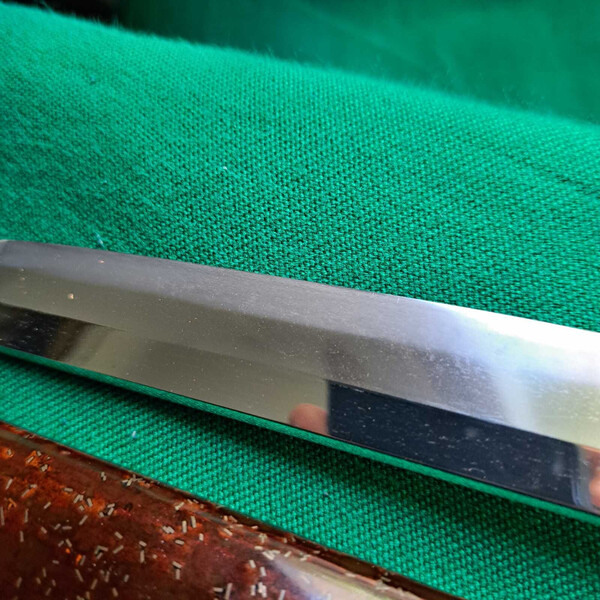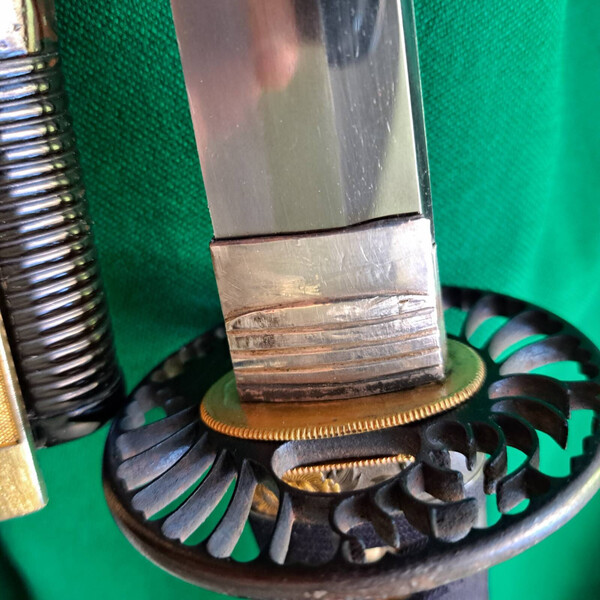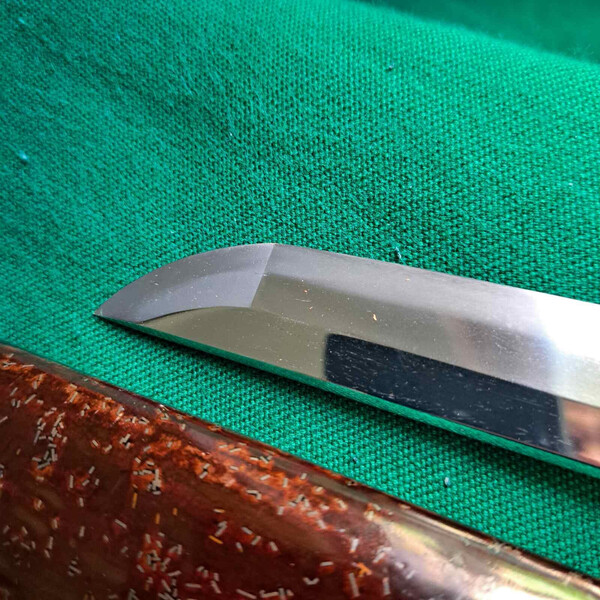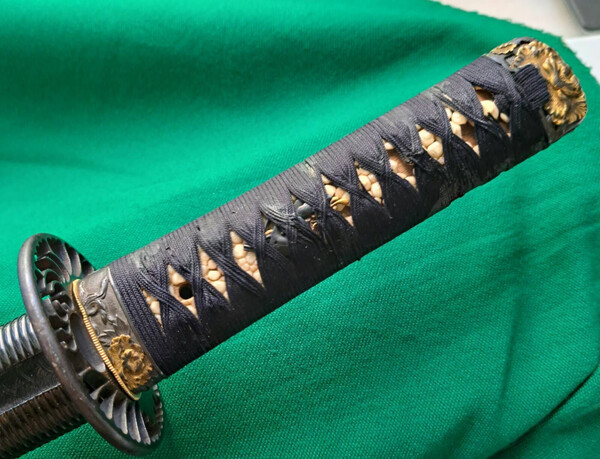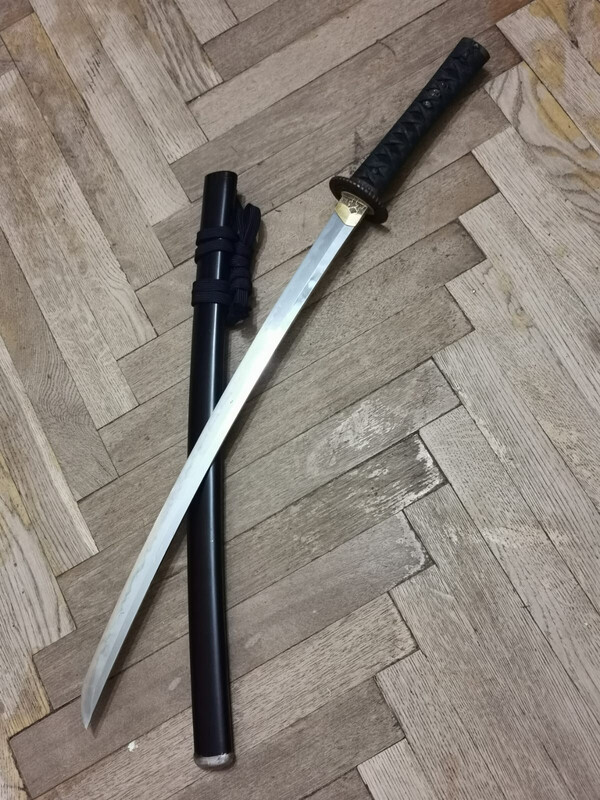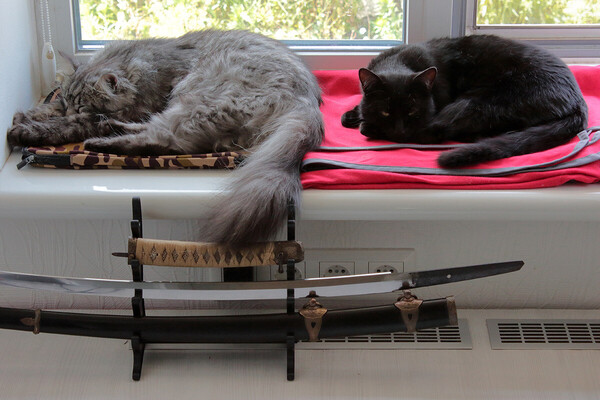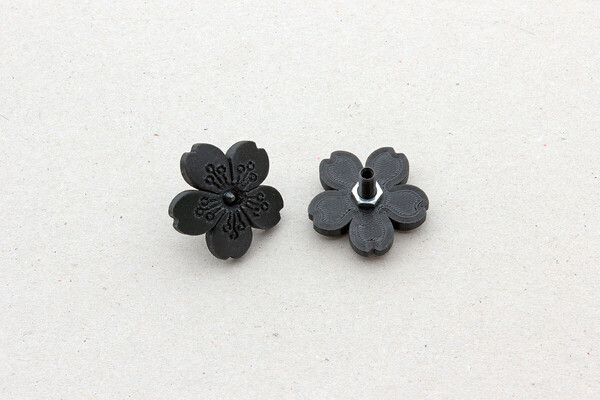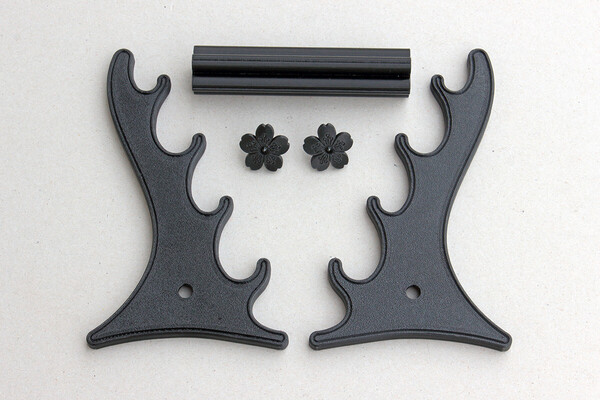-
Posts
117 -
Joined
-
Last visited
Content Type
Profiles
Forums
Events
Store
Downloads
Gallery
Everything posted by Nazar
-
Bruce, here is another one from the same site: https://richard-militaria.at/Japan-marine-katana-fuer-offiziere-shin-gunto
-
-
-
Yet one souvenir sword: https://richard-militaria.at/Japan-shin-gunto-katana-fuer-marine-offiziere
-
Here is another one: https://richard-militaria.at/kaiserlich-japanisches-armee-katana-shin-gunto-fuer-offiziere
-

Another wakizashi for evaluation
Nazar replied to Nazar's topic in General Nihonto Related Discussion
Lewis, If take into account the story with fake origami papers, I wouldn't be surprised if the last two "kanji" were chiseled in Ukraine. Alex, Thank you. That is exactly my plan: stay calm and wait for opportunity. Yet, thanks to the people from this very board, things like this are quite educational. They also make me wonder if there is a limit when it comes to forgery, fakes and assemblies. -

Another wakizashi for evaluation
Nazar replied to Nazar's topic in General Nihonto Related Discussion
Marcin, many thanks to you! As soon as I read your message (the part about the background), I remembered that I already have seen this particular background too. Only on the local internet auction. Then things clicked into place in my mind. Some time ago I called some guy from Kyiv who put an ad about selling Japanese dress sword and navy dirk (dirk fittings had mismatched parts). It turned out that the dress sword was already sold but he told me that he could bring another one as his daughter lives in Japan. We had some conversation, and some of the things he mentioned made me think about the "shady seller" who offered me this very wakizashi and that previous one with fake origami papers. So I became curious and mentioned wakizashi with fake papers and at this point I noticed the change in his tone and then he quickly became "busy" and finished the call. Now I checked some current lots of this person and they have the very same green fabric for the background. So the "shady seller" and the "person with a daughter in Japan" are clearly connected. Now I know the source of Japanese blades and I believe the scheme is simple and as old as humanity: buy the cheap thing, then sell it as luxury. If you have some links to lots of that yahoo seller, it would be interesting to take a look at them. -

Another wakizashi for evaluation
Nazar replied to Nazar's topic in General Nihonto Related Discussion
Jean, I completely agree with you. And that mei looks to be a big red light by itself. Yet I was curious about the thing, so I created the topic. So to say, for educational purposes. Thank you Kirill, I wonder if that was crude attempt to make it look like the blade has something to do with Echizen Kanenori. JM, Alas, I am living in a country where Japanese blades tend to be overpriced. Like I regularly see prices of 3K USD for showato. Never have seen them actually sold though -

Another wakizashi for evaluation
Nazar replied to Nazar's topic in General Nihonto Related Discussion
These are the only available pictures. I processed the photo of mei to make it more visible and to position it in an appropriate way. What I was able to make from first four kanji is: "越前国住". Yet I am not sure if I am right or wrong. -

Another wakizashi for evaluation
Nazar replied to Nazar's topic in General Nihonto Related Discussion
-
The same seller that offered me previous gimei wakizashi popped again with a new offer. It's another wakizashi. The thing that makes me dubious from the starter is mei. It looks like two last "kanji" were added by an inept person. Yet I am interested in your opinion on this wakizashi. Also it's an evaluation of the seller. I already formed my opinion on his being some shady personality with dubious lots for sale.
-

Shin Gunto Japanese Sword - real?
Nazar replied to Susana Ferreira's topic in Military Swords of Japan
Encountered similar fake on our local auction too: https://violity.com/ua/120509033-yaponskij-vijskovij-kortik-do-1945r?utm_source=follow&utm_medium=yaponskij-vijskovij-kortik-do-1945r&utm_campaign=17 999uah -

Need your expertise on wakizashi.
Nazar replied to Nazar's topic in General Nihonto Related Discussion
Thank you Geraint! Shame on me for ctrl+c ctrl+v -

Need your expertise on wakizashi.
Nazar replied to Nazar's topic in General Nihonto Related Discussion
Thank you, Ed. If you read through my first post, you may find that before I created the topic I already knew the papers were fake. As you said, fortunately there are resources online today, so I did exactly as you said. I studied and figured out on my own that: First, the papers don't match the actual mei on nakago. Second, the round stamped seal shouldn't be on green papers. And third, papers were tampered locally in Ukraine. After this I disregarded papers, but I still was interested in this wakizashi, papers or no papers.I figured out that the mei is Bitch no Kami Tachibana Yasuhiro and (thanks to this very Board) managed to find that there were four generation of swordsmiths that signed swords in this way. Yet, as the papers turned out to be a scam, I had to find out if the mei was genuine. Exactly at this stage I asked for expertise on the sword. Thanks to Jacques, he confirmed my fears that this wakizashi is gimei. So I believe I did my homework before I bothered you. -

Need your expertise on wakizashi.
Nazar replied to Nazar's topic in General Nihonto Related Discussion
Thank you, Jaques! Alas for the sword, I liked it. Chris, thank you for the great story. Marcin, as I said, I liked this wakizashi. So if it was not gimei I'd consider buying it even with no papers (with some negotiations on price, sure). Thank you, John! Thank you for the information! Yes, I figured out that photos were replaced by some local persons. Will not buy this sword. This whole story may be sad for the seller, but I believe he will worm his way out with this wakizashi. For me it was very educational, so thanks once more to all who participated in this topic! -

Need your expertise on wakizashi.
Nazar replied to Nazar's topic in General Nihonto Related Discussion
-
Need your expertise on wakizashi. Yesterday night one local seller approached me offering this Wakizashi. The price he asks is USD 3850. Seller states total length is 80cm, length of blade 57cm. He sent me a bunch of photos along with some photos of Tokubetsu Kicho Origami. And Origami became my main concern. I figured that it was issued in 1970, and found the article on how to read it. Yet, I found the section where description has to be confusing to read. The section where mei has to be does not match mei on photos of nakago in Origami. Also I noticed that photos of nakago stamped with a round stamp that looks like a stamped seal from Tokubetsu Hozon papers. I went through some Tokubetsu Kicho Origami pictures and none of them have round stamped seals. They all have identical rectangular stamps on areas with pictures and with writings. I asked Jean (ROKUJURO) for help. Thanks to him for his expertise and especially for confirmation that my confusion of Origami wasn't baseless! Ater Jean's words it all clicked together. The papers turned out to be tampered. As you may see, the photos of Nakago were made on the graph paper. It intrigued me from the start since such kind of paper was (and is) popular here. I used it as a student and later on I used it in my workshop to make blueprints for some complicated shapes. Meanwhile, photos for Green Paper Origami usually have a plain paper for background. I was taking a closer look at the stamp on photos when I noticed something so obvious that it's a shame I didn't notice it earlier. There is +38 and part of 0 visible on the blank edge of graph paper. It's an international code for Ukrainian phone numbers. Obviously it's part of a phone number printed by the manufacturer of graph paper that was used by some local "geniuses" for the background of nakago photos. And sure, after that one may spot the remains of the original picture/photo and the red rectangular seal in between photos of nakago. However, I like this wakizashi and its fittings, especially habaki. So I am interested in the opinion of this community on this sword. Here is a complete set of photos sent to me by the seller: https://drive.google.com/drive/folders/1YXsMuJVrYOapahQZp7eoXg0Z4kzNURi4?usp=sharing I believe I may figured family of swordsmiths with this signature 備中守橘康廣 (if signature is genuine of course): https://nihontoclub.com/smiths/YAS804 https://nihontoclub.com/swords/0000-0766 https://www.militaria.co.za/nmb/topic/10073-absolute-amateur-needs-translation-help/
-
Thank you, Rob! I agree, wood is a more appropriate material when it comes to displaying Japanese swords. That's why I consider this stand to be a "field" grade. Yet, new times bring new technologies and I already see the application for 3D printing in many spheres. Also, I believe it is possible to combine old and new techniques. In my dreams I see how I could use both sculpture clay and 3D modeling/printing for my before-the-wa occupation. And even now I always keep at hand some paper and pencils.
-
Thank you Brian, I do use 3D printing extensively for war purposes. It was a pleasure to design and print this stand for a change. I do not mind sharing STL files for this stand. The members of this community give me a lot of expertise and advice. So to me sharing these files would be like saying thanks to you all. We may do it this way: I'll prepare the files and DM them to you and you could put them in the download section of this board.
-
-
And here it is with dirks on it. Then I bought the sword and encountered the same issue as with dirks: I didn't like the idea of the blade or saya or tsuka being tossed around the table. I checked if a sword could be placed on the stand that I made for dieks and it turned out it fits pretty well. So I printed yet another stand but with a longer bar. The length of the bar was set by the length of tsuka. In this way I was able to keep my "project sword" safely on the stand assembled or disassembled.
-
The screws that hold the whole thing together replicats design of navy dirk mekugi screws. Alas, my 3D printers are not top end ones, so the faces of cherry blossoms aren't perfect. I equipped them with M5 set pins that are locked in place by nuts. And as metal set pins tighten 3D printed parts together, the joint is very reliable. That's how my stand looks assembled.
-
So the story of my first Japanese sword is finished. At least for the time being. I bought a maintenance kit from Toshiro Swords, which includes oil and uchiko powder. I believe uchiko powder wouldn't harm this blade. Already applied it a couple of times. However, the general idea is to keep the blade regularly oiled. Yet, I wouldn't bother you with small things. Actually, the final part of the story is about the stand I made for this sword. . It all started when I bought my second navy dirk (and it was the first not frankendirk as well). At first both dirks were laying on my desk on a sheet of paper towel to avoid unnecessary scratches. Not the best option though, so soon I got this idea to design and make a stand for them. The idea had some particular features from the starter, so it didn't take me long to work out all the details. First I made an initial drawing in an old fashioned way, using pencil and paper. Then I spent some time in SolidWorks, drawing, adjusting dimensions and adding final "brushstrokes" to the parts. I had only a general idea of how a stand for Japanese swords looks, and since I was designing a stand for navy dirks, it so happened that the painting "The great wave of Kanagawa" popped into my mind. I couldn't even remember when I saw the reproduction of that painting, but it turned out it lived in some corner of my memory for many years. And it has become a source of inspiration for sides of the stand. Yet, I kept myself from reviewing the picture again until I finished this stand of mine. Also, the idea was to make a "field" grade stand, so I could easily assemble/dismantle it when I have to move to a new place. In this case inspiration came from navy dirks themselves. The cherry blossom mekugi/menuki screw gives me ideas on how to make the stand not only easy to assemble but also rigid. So here is how the set of ready parts looked once I finished designing and 3D printed them. Side plates have grooves on the outer and ridges on the inner sides. This makes them more rigid. Long ago I equipped all my 3D printers with magnetic tables. This provides a nice texture to the outer sides. The bar that joins the side panels is a cross section of cherry blossom head of mekugi screw. This design provides both lateral and torsional rigidity to the part. Central hole is threaded. Side plates have sockets for this bar. In this way there is no need to align panels.
-
Thank you, Brian. Our local market of Japanese blades is quite a chimera. Things tend to be overpriced and there is a significant amount of fraud. Especially when it comes to dirks. I already have seen replicas of dirks and one of them was made not by Japan Sword ltd, but another company that I believe is also located in Japan. They were sold as genuine dirks. There are some clear assemblies, with chinese knock-off elements of fittings. I even started to collect photos of these assemblies and replicas.
-
Thank you, Bruce!






